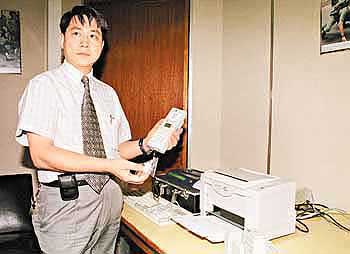Force ups the ante with drink drivers
 "Under the limit, or under arrest?": SSGT Wong Kam-wah demonstrates new breathalysing tools |
The Force is considering extending drink-driving enforcement to other formations such as Emergency Units and District Traffic, as only Regional Traffic officers enforce the drink-driving law at present.
The proposal comes as tough new legislation was introduced on October 1, cutting blood-alcohol limits from 80 milligrams per 100 millilitres of blood (0.08), to 50 milligrams (0.05).
The changes also allowed registered or enrolled nurses to take blood specimens in addition to doctors and allowed the Commissioner of Police to designate a place or vehicle for use as a test centre. They also allow the requirment for a provision of a blood sample to be taken at police stations and breath test centres.
More breath-testing equipment would also be commissioned in the coming months.
Traffic Branch Headquarters Chief Inspector John Lau To-sang said that by allowing other units to enforce drink-driving laws, a higher number of offenders were likely to be caught.
"Only Regional Traffic officers are enforcing drink-driving laws at the moment, so EU and District Traffic officers are also being considered. District Traffic officers generally just deal with minor traffic offences but this could see their role expanded," Mr Lau said.
"And we have found EUs often encounter suspect drink drivers at accident scenes. However, at present, they must call Regional Traffic for assistance in testing these motorists. By the time the Traffic officer arrives, the suspect may sober up a little and fall back under the limit before we can test him."
He said the changes were important as 82 per cent of positive cases involved a traffic accident. About 16 fatalities last year were found to be alcohol related.
Along with the tightened limit, the Branch also hoped the commissioning of more equipment would cut the number of drink drivers.
Chief Superintendent (Traffic) Ian Stenton said the Force so far had 240 portable breathalysers, and 18 evidential devices, which could print out the test result for use as court evidence. Another 90 screening devices and four evidential machines were due for delivery by the end of next month.
Each Traffic officer would then be equipped with a portable breathalyser and more stations would house the evidential device, giving drinkers strong incentive to think twice before driving home.
Mr Stenton said that as a proactive measure, Police would step up action to intercept drink drivers before they caused an accident.
"Drivers may be breathalysed when they are found to have committed moving traffic offences such as reckless or careless driving, speeding and crossing double white lines," he said.
"If you drink, you can't drive. Anyone intending to drink should use public transport, take a taxi or have a non-drinker drive on their behalf." Since the introduction of the drink driving legislation in mid-December 1995, 3,469 or 4.1 per cent of the 83,762 drivers breathalysed were found to have an alcohol concentration exceeding the prescribed limit.
Of these 3,469 drivers, 2,833 (82 per cent) were involved in traffic accidents.
Among these, 2,294 were convicted of various drink driving offences, with eight of them sentenced to imprisonment from 21 days to two months.
Depending on the seriousness of individual offences, fines ranging from $500 to $20,000 and disqualification from one month to 48 months were meted out.